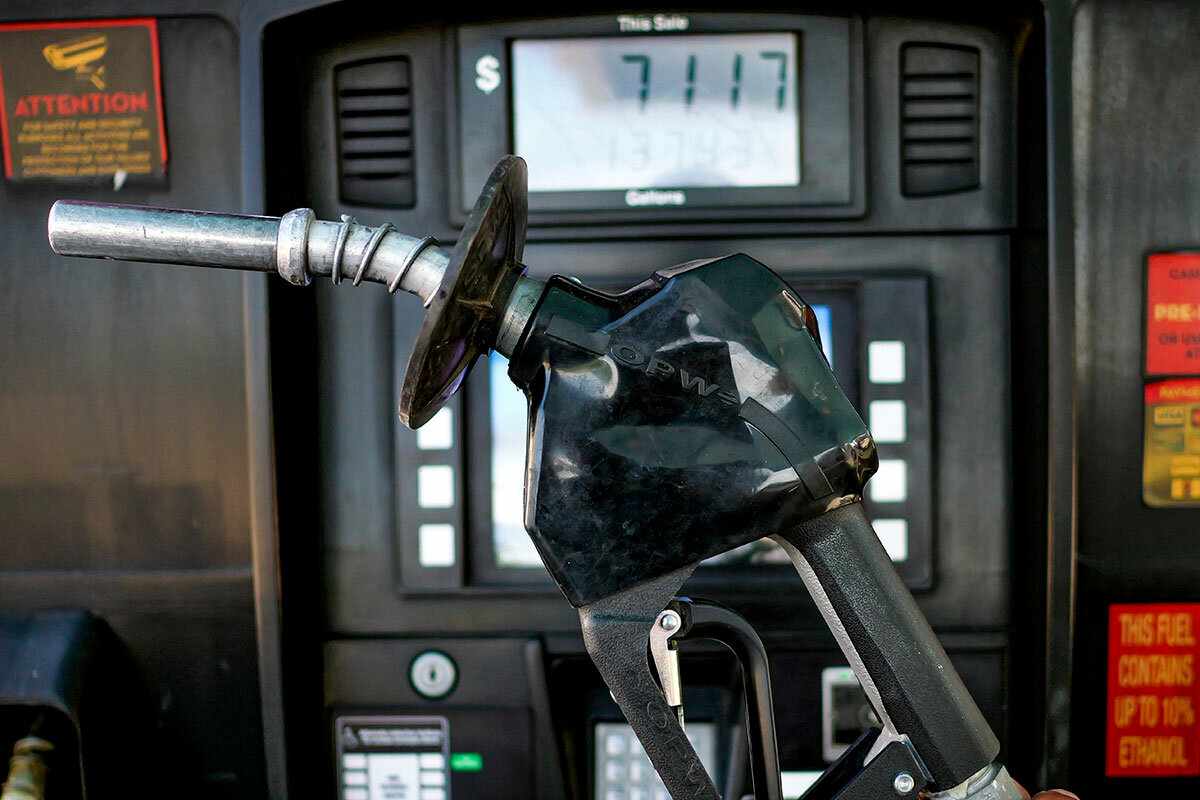Gas price spike: Who’s to blame and how can we fix it?
Loading...
Americans are watching closely: $4.48 in Georgia. $5.05 in Ohio. $6.44 in California. Week by week, the numbers at gas station pumps have been rising.
Residents of other countries are used to higher prices, generally over $10 a gallon in Hong Kong and around $7 to $9 in most of Europe. But the United States has long counted on comparatively cheap gas to fuel a car-centric economy.
Average U.S. gas prices hit an unprecedented $5.01 on June 15, an upward trend that is contributing to a 40-year high in inflation. To slow inflationary pressure, the Federal Reserve hiked short-term interest rates by 0.75 percentage points on Wednesday in the biggest jump in 28 years.
Why We Wrote This
A story focused onSurging gas prices weigh on consumers around the globe. A lot of blame is going around. But the issue is also raising questions of responsibility in a different sense: how to take better charge of our energy future.
As anxieties mount, fingers are pointing. Turn to social media, and it seems one of two culprits is to blame for current gas prices: price-gouging corporations, or U.S. President Joe Biden. The Biden administration, meanwhile, has dubbed the situation “Putin’s price hike.”
The real story is nuanced. For starters, this is not a purely American problem: Canada, the United Kingdom, and other countries are facing record-high prices too. Economists are quick to note that the oil market is a global one, affected by shocks to supply and demand, like the world’s emergence from the pandemic and, yes, Russia’s invasion of Ukraine.
The high prices are a pressing reminder of humanity’s need to shift away from fossil fuels due to climate change. While no one is shaming consumers, both buyers and sellers are responsible for market movements – and demand for fuel has rebounded because of consumers’ choices as well as their necessities.
What has driven prices up?
As is often the case, it’s a combination of things.
Gas prices usually follow the price of crude oil, which generally accounts for about half of the pump price but has grown to 60% in recent months. When the pandemic began, travel and industry slowed, dramatically lowering demand for crude oil. Oil companies responded by lowering production and laying off workers, in some cases shutting down refineries. As society opened up again, pent-up demand surged while global production has lagged.
Several factors explain the production gap. Rising input costs and supply-chain bottlenecks for equipment like casing and coiled tubing have made it difficult to increase supply quickly. Longer-term, oil and gas companies are hesitant to invest in oil infrastructure, given international ambition to phase out fossil fuels, including President Biden’s decision to cancel the Keystone XL pipeline.
Then Russia invaded Ukraine on Feb. 24. Prices were already rising before the invasion, but accelerated when the European Union and the U.S. moved to cut Russian oil from their energy supply.
“Western reluctance to buy Russian oil is working,” says Chris Knittel, professor of applied economics at the Massachusetts Institute of Technology. “That means Russia is able to sell less oil [and] world prices are going to have some upward pressure.”
In 2021, only 8% of U.S. petroleum-product imports came from Russia, but less Russian oil on the market makes crude oil more expensive for everyone.
What’s being done?
President Biden responded to calls to increase U.S. oil supply by releasing 1 million barrels per day from the Strategic Petroleum Reserve. But the move has made little impact on prices, which Dr. Knittel says isn’t surprising, given daily global consumption of around 100 million barrels. And even if Mr. Biden were to expand drilling on federal lands – a move some have called for – any resulting supplies wouldn’t show up quickly.
On Tuesday, Mr. Biden announced that the EPA will allow the sale of a blended biofuel known as E15, long resisted by some environmental groups, over the summer for short-term relief. He is also considering negotiations with the oil-producing nations of Saudi Arabia, Iran, and Venezuela to increase supply, though those effects wouldn’t be felt soon and could raise ethical concerns.
Meanwhile, a handful of states temporarily suspended gas taxes, which account for anywhere from 9% to 19% of the pump price, with more considering similar proposals.
Addressing what some see as a greed-induced crisis on the part of oil and gas companies, which saw record-breaking profits in the first quarter of 2022, Mr. Biden sent a letter to major firms this week saying that excessive margins are “worsening that pain” for consumers.
Already, Democratic lawmakers had pulled together a Consumer Fuel Price Gouging Prevention Act. The legislation passed the House in May along partisan lines but faces a tough battle in the Senate. For opponents, high profits are a reasonable result of market forces, and do not necessarily imply price-gouging.
What’s next?
The challenge lies in weighing both future and present needs.
“These companies are investing in a low-carbon future that in the short-term still requires the production of fossil fuels for consumers who need it today,” says Devin Gladden, AAA National’s manager for federal affairs.
The U.S. Energy Information Administration predicts a drop in gasoline prices by 2023, but that will depend on how sanctions continue to affect Russian oil production, the amount the Organization of the Petroleum Exporting Countries decides to produce, and to some extent the rate of drilling expansion in the U.S.
In the meantime, Mr. Gladden says the current scenario is opening consumers’ eyes to the reality and necessity of the energy transition: “If it’s in the budget to make that switch to an electric vehicle, they’ll do it.”
Those who can’t afford a higher-efficiency car, or can’t buy an electric vehicle due to supply-chain hiccups, are more likely to bike, carpool, combine or reduce trips, and use public transportation where available.
For Dr. Knittel, now is a chance to reassess our collective dependency on oil. To phase out fossil fuels without hurting consumers, demand will need to fall in tune with decreased production.
“We can’t affect the price, but we could affect how much we need to buy, and that’s what I hope policymakers are focusing on these days.”








